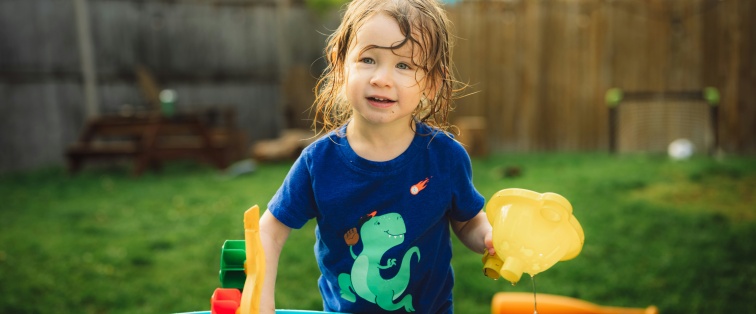The Heat Is Turned Up: Focus on Climate Solutions for Kids


2023 was the hottest year on record and 2024 is predicted to rank among the top five warmest years. Extreme heat at this scale can be a danger to not only the physical health of children, but also has impacts related to mental health and educational disruptions.
Around the world and in our Philadelphia community, we know the burden of extreme heat impacts some more than others. The Philadelphia Heat Vulnerability Index shows that some neighborhoods can have up to a 22 degrees Fahrenheit heat discrepancy on a given day. Heat “amplifies the effects of systemic inequities in housing, neighborhood density, community infrastructure, and economic opportunity, contributing to an unequal burden of dangerous conditions for families from marginalized groups and with lower incomes.”
Climate change has been recognized by the World Health Organization (WHO) as a “fundamental threat to human health” and is a key driver behind increasing extreme heat. These links between the changing environment and human health drove me to serve as a delegate to the United Nations Climate Change negotiations in 2014 and 2015, where the historic Paris Agreement was signed. From this experience, I saw firsthand how clinicians have an opportunity to share perspectives not always represented at decision-making tables, especially those of children. This inspired me to go to medical school.
Now, as a pediatric resident, I see how children are impacted by increasing heat: from school closures to heat-related illness. I recently returned to the United Nations Climate Change negotiations (COP28) to amplify the stories of my patients.
As we feel the heat, the pressure is mounting for action. Below, I share key takeaways from a recent working paper on extreme heat and child development from Harvard University’s Center on the Developing Child and review proposed solutions to address this issue locally and globally. By better understanding this topic and potential solutions, clinicians can serve as effective messengers on climate action for health.
The impact of extreme heat on children's health
Earlier this year, The Early Childhood Scientific Council on Equity and the Environment at The Center on the Developing Child at Harvard University released a working paper entitled Extreme Heat Affects Early Childhood Development and Health. The paper reviews many ways children are uniquely vulnerable to heat, including:
Pregnancy: Heat stress on pregnancy can lead to preterm births, lower birth weights or increased rates of stillbirth.
Thermoregulation: The smaller size of infants and young kids means their bodies not only heat up quicker than adults, but also release less heat via sweating. They also rely on others to keep them safe—from getting them to a cooler place to offering appropriate hydration.
Nutrition: Children have higher nutrition and fluid requirements than adults. As extreme heat impacts food and water supplies through drought and agriculture, children suffer.
Disruptions in Education: Heat can contribute to “slower cognitive function and reduced concentration ability” which can impact students’ performance in school and contribute to learning challenges during childhood.
Sleep Quality: Extreme heat can disrupt the body’s natural cooling before sleep and contribute to poor quality sleep. Poor sleep during infancy and childhood may contribute to increased weight, emotional challenges and reduced problem-solving skills.
Mental Health: Extreme heat can activate the body’s stress response system, threatening healthy emotional regulation development. Extreme heat has also been associated with increased rates of violence, crimes, and conflict—which can have long-term consequences for a child’s mental health.
Here in Philadelphia, we see examples of these impacts with our patients. The Asthma and Allergy Foundation of America identified Philadelphia as one of the most challenging cities in the U.S. for people with asthma. Extreme heat contributes to worsening air quality and will only further exacerbate this challenge. Schools in Philadelphia close during extreme heat without adequate cooling systems in place. These disruptions in education can have lasting impacts on children. And, stemming from historically racist practices like red lining, we see that the burden of extreme heat disproportionately impacts some neighborhoods more than others, further exacerbating existing health disparities.
Approaches and Solutions to Address Extreme Heat and Support Family Health
Strategies to mitigate extreme heat will support the health and well-being of children. The working paper lays out a framework for us to shape these strategies through: (1) Immediate Actions, (2) Infrastructure Adaptations and (3) Addressing Root Causes. Solutions must also be multi-disciplinary and involve local community members. Examples include:
Partnerships with schools, after-school/summer programs, or sports can focus solutions to where children are spending their time during periods of extreme heat.
Urban planning and urban greening campaigns can increase canopy coverage and heat reduction across communities to safeguard against higher temperatures.
Cooling solutions including air conditioners, heat sinks or swamp coolers can be made more available through programs like the Low Income Home Energy Assistance Program (LIHEAP). LIHEAP may also offer support for energy bills.
Multi-disciplinary heat action plans can strengthen community resilience in the wake of more frequent and severe extreme heat days.
Locally, several organizations are leading the way to advance discussions around climate and the connection to health. Last year, Perry World House hosted a Heat-Health Colloquium to discuss policies and offer recommendations to support resilience to extreme heat, including in health care by increasing clinician and patient knowledge regarding heat stress. Recognizing the urgency for multi-disciplinary solutions, Drexel University recently established the Climate Change and Urban Health Research Center to support ongoing research on the intersection of health, equity and climate change.
Extreme heat is a significant threat to the health of children, and we must consider a holistic and multi-faceted approach when crafting solutions. Clinicians are well-positioned to serve as advocates in this space given our unique lens into the multitude of ways that the environment impacts children's health. The heat is up and the time to act is now.

